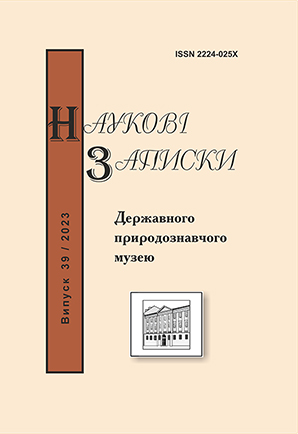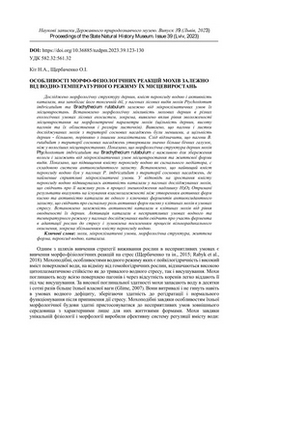Kit N.A., Shcherbachenko O.I.
Peculiarities of the morpho-physiological reactions of mosses depending on the water-temperature regime of their local growth // Proc. of the State Nat. Hist. Mus. - Lviv, 2023. - 39. - P. 123-130 DOI: https://doi.org/10.36885/nzdpm.2023.39.123-130 Key words: mosses, microclimatic conditions, morphological structure, life form, hydrogen peroxide, catalase The morphological structure of and the activity of the catalase of mosses Ptychostomum imbricatulum and Brachythecium rutabulum depending on microclimatic conditions of their local growth were studied. The morphological variability of moss turfs in different ecological conditions of forest ecosystems was established, in particular, the influence of the level of moisture in local growth on the morphometric parameters of mosses (the density of the turf, the height of the shoots and their foliage and the size of the leaves) was revealed. It is shown that the morphological structure of the turfs of the mosses Ptychostomum imbricatulum and Brachythecium rutabulum is important for moisture conservation and depends on the microclimatic conditions of local growth and the life form of the species. It is shown that the increase in the content of hydrogen peroxide as a signaling mediator is a component of the antioxidant protection system. It was established that the highest content of hydrogen peroxide was in shoots of P. imbricatulum from the territory of pine plantations, where the microclimatic conditions are the least favorable. The obtained results indicate the existence of interdependence between the formation of reactive oxygen species and the activity of catalase as one of the key enzymes of antioxidant protection, which indicates the signaling role of reactive oxygen species in moss cells under stress conditions. The dependence of catalase activity in moss cells on the level of hydration of their turfs was established. The activation of catalase in adverse water and temperature conditions in the shoots of the studied species indicates the participation of the enzyme in the adaptation of plants to stress and is due to the strengthening of free radical oxidation processes, in particular, an increase in the content of hydrogen peroxide.
Peculiarities of the morpho-physiological reactions of mosses depending on the water-temperature regime of their local growth // Proc. of the State Nat. Hist. Mus. - Lviv, 2023. - 39. - P. 123-130 DOI: https://doi.org/10.36885/nzdpm.2023.39.123-130 Key words: mosses, microclimatic conditions, morphological structure, life form, hydrogen peroxide, catalase The morphological structure of and the activity of the catalase of mosses Ptychostomum imbricatulum and Brachythecium rutabulum depending on microclimatic conditions of their local growth were studied. The morphological variability of moss turfs in different ecological conditions of forest ecosystems was established, in particular, the influence of the level of moisture in local growth on the morphometric parameters of mosses (the density of the turf, the height of the shoots and their foliage and the size of the leaves) was revealed. It is shown that the morphological structure of the turfs of the mosses Ptychostomum imbricatulum and Brachythecium rutabulum is important for moisture conservation and depends on the microclimatic conditions of local growth and the life form of the species. It is shown that the increase in the content of hydrogen peroxide as a signaling mediator is a component of the antioxidant protection system. It was established that the highest content of hydrogen peroxide was in shoots of P. imbricatulum from the territory of pine plantations, where the microclimatic conditions are the least favorable. The obtained results indicate the existence of interdependence between the formation of reactive oxygen species and the activity of catalase as one of the key enzymes of antioxidant protection, which indicates the signaling role of reactive oxygen species in moss cells under stress conditions. The dependence of catalase activity in moss cells on the level of hydration of their turfs was established. The activation of catalase in adverse water and temperature conditions in the shoots of the studied species indicates the participation of the enzyme in the adaptation of plants to stress and is due to the strengthening of free radical oxidation processes, in particular, an increase in the content of hydrogen peroxide.
References
- Аринушкина Е. В. 1970. Руководство по химическому анализу почв. М. 488 с.
- Баїк O.Л., Kiт Н.A. 2022. Морфо-фізіологічні реакції мохів на дію абіотичних чинників на посттехногенних територіях видобутку сірки. Вісник Львівського університету. Серія біологічна. № 87. С. 76 –89. DOI: https://doi.org/10.30970/vlubs.2022.87.07
- Буздуга I.M., Волков Р.А., Панчук І.І. 2020. Втрата активності каталази 2 впливає на обмін аскорбату в арабідопсису за дії важких металів. Фізіологія рослин і генетика. Т. 52 № 4. С. 306−319. DOI: https://doi.org/10.15407/frg2020.04.306
- Гончарова И.A. 2005. К вопросу о структуре дерновины и продуктивности сфагновых мхов на олиготрофных болотах. Сибирский. экол. журн. № 1. С. 131−134.
- Демкив О. Т., Сытник К. М. 1985. Морфогенез архегониат. Киев : Наук. думка. 204 с.
- Іващенко О.О., Іващенко О.О. 2019. Проблеми стресів у рослин і способи їх розв’язання. Вісн. аграрн. науки. № 7. С. 27−35. DOI: https:/doi.org/10.31073/agrovisnyk201907-04
- Лакин Г. Ф. 1990. Биометрия: Учеб. пособие для биол. спец. вузов. 4-е изд. М. 352 с.
- Колупаев, Ю. Э. 2016. Антиоксиданты растительной клетки, их роль в АФК-сигналинге и устойчивости растений. Успехи современной биологии. Т. 136 № 2. С. 181–198.
- Королюк М.А., Иванова Л.И., Майорова И.Г., Токарев В.Е. 1986. Метод определения активности каталазы. Лабораторное дело. № 1. С. 16–20.
- Польчина С. М. 1991. Методичні рекомендації до лабораторних і практичних робіт з ґрунтознавства. Чернівці. 60 с.
- Щербаченко О.І., Рабик І.В., Лобачевська О.В. 2015. Участь мохоподібних у ренатуралізації девастованих територій Немирівського родовища сірки (Львівська область) // Укр. ботан. журн. Т 72 № 6. С. 596–602.
- Di Toppi L., Lambardi M., Pazzagli L. et al. 1999. Response to cadmium in carrot in vitro plants and cell suspension cultures. Plant Science. Vol. 137. P. 119–129.
- Gechev T.S., Hille J. 2005. Hydrogen peroxide as a signal con-trolling plant programmed cell death. J. Cell. Biol. T. 168 № 1. P. 17–20.
- Glime J. M. 2007. Bryophyte Ecology. Vol. 1. Physiological Ecology. Ebook sponsored by Michigan Technological University and the International Association of Bryologists. Accessed on: 03.11.2019 at: http://www.bryoecol.mtu.edu
- Leung D. 2018. Studies of Catalase in Plants Under Abiotic Stress. In book: Antioxidants and Antioxidant Enzymes in Higher Plant. Р. 7−39. DOI:10.1007/978-3-319-75088-0_2
- Mittler R., Vanderauwera S., Suzuki N., Miller G., Tornetti V.B., Vandepoele K., Gollery M., Shulaev V., Van Breusegem F. 2011. ROS signaling: the new wave? Trend Plant Sc. T. 16. P. 300-309.
- Proctor M.C.F., Tuba Z. 2002. Poikilohidry and homoiohydry: antithesis or spectrum of possibilities. New Phytologist. Vol. 156. P. 327−349.
- Pucciariello C., Banti V., Perata P. 2012. ROS signaling as common element in low oxygen and heat stresses. Plant Physiol. Biochem. T. 59. P. 3−10.
- Rabyk I.V., Lobachevska O.V., Kyyak N.Y., Shcherbachenko O.I. 2018. Bryophytes on the devastated territories of sulphur deposits and their role in restoration of dump substrate Biosystems Diversity. 26 (4). Р. 339−353. DOI:10.15421/011850
- Wang W., Cheng D., Liu D. 2019. The Catalase Gene Family in Cotton: Genome-Wide Characterization and Bioinformatics Analysis. Cells. Vol. 8 № 2. Р. 86–114. DOI:10.3390/cells8020086


